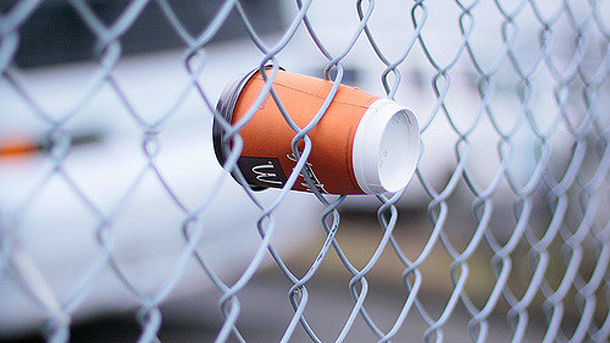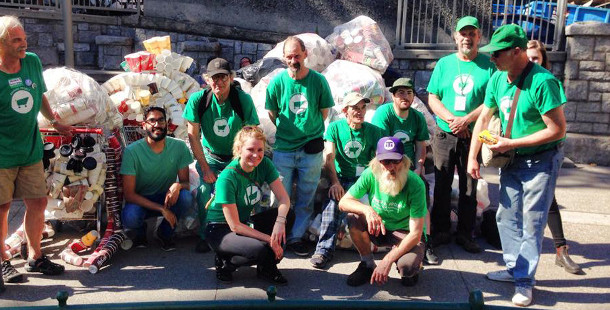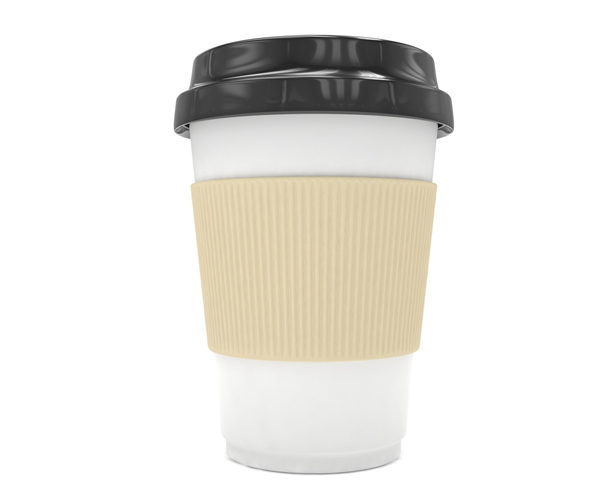[Editor's note: This article was originally published by Sightline Institute, and is reprinted with permission.]
What would you do to save a few pennies? Thirty to 45 per cent of shoppers will remember their reusable grocery bags to save on a five-cent bag tax. Consumers will wash out and return 70 per cent of recyclable bottles to cash in on bottle bill refunds. But fewer than two per cent of coffee lovers will bring their own mugs to Starbucks to save a dime on their beverage. Why do people work hard to save on their bags and bottles but not on their cups of joe?
Many coffee shops have tried to promote reusable mugs by offering a 10-cent discount to customers who bring their own cups to the café. Starbucks, Seattle's Best, and Peet's all offer the discount, as do many local coffee shops, like The Hof and Ugly Mug in Portland and Cloud City Coffee in Seattle. Chances are, if a place sells coffee, it will give you a discount for remembering your tumbler. But few caffeine addicts are taking advantage.
The same few pennies charged as a fine turn out to be much more effective at curbing wasteful practices than when they come in the form of a small bonus or savings. Consumers hate being fined but rarely go out of their way to save a few cents (just think of all the times you've passed on coupons).
Several other obstacles stand in the way of a reusable-mug renaissance: carrying around a tumbler is inconvenient; unique travel-mug sizes can give baristas trouble; and, interestingly, the paper coffee cup has also become a status symbol, a signal of wealth and a busy schedule, and consumers are loathe to give that up.
So what can we do to meet these challenges and make reusables the new norm in Cascadia?
What works: Two case studies
Loss aversion: The case of the bag tax
Bag taxes, like those in Corvallis, Seattle, and Bellingham, charge consumers five to 10 cents for each disposable grocery bag they use per shopping trip. This charge has proven to be highly effective in prompting customers to bring their own bags to the store and avoid the fine. In Seattle, nearly 50 per cent of stores reported a decrease in disposable bag use six months after the implementation of a five-cent charge on paper bags. Ireland, which introduced a bag tax of about 19 cents in 2002, saw an even more dramatic decrease: consumers there used 94 per cent fewer disposable bags in the first year of the program (!), and they continued to keep their consumption under 10 per cent of former usage five years later.

Consumers are much more motivated to avoid a fine than to take advantage of a reimbursement, according to numerous behavioural economics studies (like this one.) The bag tax in Montgomery County, Maryland, provides a good illustration. Before the County implemented its five-cent charge on disposable grocery bags, many stores offered a five cent bonus to customers who brought their own shopping bags. These stores saw almost no increase in reusable bags: 82 per cent of customers used disposable bags in bonus stores, compared to 84 per cent in stores offering no bonus. Once the five-cent tax on disposable bags kicked in, however, use of disposables plummeted, and only 39 per cent of customers used the taxed bags. It's the same five cents, but when it's a tax and not a refund, it carries a lot more weight with consumers.
But implementing a fee on disposable hot drink cups would also mean battling industry pushback. Though jurisdictions such as Kassel, Germany; Toronto, Canada; and the nation of South Korea have attempted to introduce such a fee, none has yet succeeded. For example, McDonald's successfully challenged Kassel's 30-cent charge on disposable cups in restaurants and cafés and eliminated the program from all cities in the country (see page 45).
The impact of income: The case of bottle bills
Bottle bills also offer a small cash motivator to change consumption habits, and they yield even greater participation rates than bag taxes. Two Cascadian jurisdictions, British Columbia and Oregon, have bottle bills. In these places, customers pay a five- to 10-cent deposit on every beverage bottle they purchase and get the money back when they return the empty and clean bottles to the store or other collection facility. Bottle recovery rates in these two jurisdictions are an impressive 70 to 80 per cent, well above the United States' national bottle recovery rate, which remains persistently below 40 per cent.
Low-income people disproportionately drive the success of these programs. In Santa Barbara, California, recyclers with incomes under $25,000 receive 58 per cent of all bottle return refunds, representing returns of far more bottles than they personally consume.
Since 2014, the Binners' Project, a group in Vancouver, B.C., has been advocating for a bottle bill-like program for coffee cups. To prove there is high interest in the program, it hosts an annual one-day event called Coffee Cup Revolution and offers a nickel for every cup turned in that day. In the latest Coffee Cup Revolution, binners across Vancouver collected 31,000 coffee cups in just four hours.

Despite high participation, the Binners' Project notes that there are numerous barriers to implementing a deposit program on hot drink cups in British Columbia, including program expense. Bottle bill programs remain viable because aluminum and plastic bottles can yield high-quality recycled products, which is not yet true of paper cups. Most hot drink cups have a polyethylene inner coating that allows them to hold liquid but also makes them expensive to recycle. In fact, only a handful of jurisdictions in Canada and the United States have recycling facilities that can process these cups, including Ontario and San Francisco. Even in these places, finding a market for the recycled product is difficult. Most often cups are shipped to Asia for processing into low-quality paper pulp. The Binners' Project hopes that in the long-term a refund system could drive recycling technology innovation and change the game for disposable cups.
Is there a better price point?
Is 10 cents just not worth the trouble of toting your own tumbler? The fact is, bringing your own mug to a café is inconvenient. Just to save one measly cup from the landfill, you have to remember your tumbler and lug it around all day.
Commuter cups can be troublesome for baristas, too. Container sizes often don't correspond to menu sizes, which makes pricing ambiguous. Is this particular Seahawks cup a grande or a venti? Add to this confusion the barista headaches of dirty mugs and tumblers that don't fit on the steamer, and you've got another serious obstacle to reuse.
And for coffee lovers, there's the missed chance to show off your cosmopolitan lifestyle by slinging around a fresh paper cup. There's just something about that crisp white cylinder that's hard to let go of.
Cafés on the University of Washington's campus offer a 25-cent discount to customers who bring their own mugs, and they report that about 12 per cent of beverages bought on campus are filled in personal mugs. Similarly, Seattle University offers a 20-cent discount for customers toting their cups, and it sees 13 per cent participation on campus. Though that's a nice bump up from Starbucks' two per cent refillable rate, it still isn't comparable to the success of bag taxes and bottle bills. It's clear, then, that price isn't the only factor stopping customers from lugging a mug.
If Cascadian cities taxed disposable coffee cups, they would likely curb consumption, because fees change behaviour more than discounts. So this proposal is worth considering, even though it carries a number of implementation obstacles. Passing a new fee on coffee cups is unlikely to be popular with customers or coffee shops, and it doesn't address barista concerns of unique sizes and clean cups.
That said, there may be a different option, one that might grow organically until it trims the pile of over 2.3 billion (yes, billion) disposable hot drink cups thrown away in Cascadia every year. (That equals two-and-a-half cups thrown out by every Cascadian every week!) Read on...
Is price the wrong question altogether?
Maybe price, tax, and bonus are the wrong questions -- or at least not the first questions we should be asking. Changing the culture of reusables could reveal an even more effective path forward, addressing some of reusables' more cost-resistant barriers.
As Cascadia has pioneered so many green cultural firsts, and indeed become known for its green soul, why not take on one more such opportunity -- especially one tied to another of our cultural icons: coffee. In fact, we've already got some great example programs in our own backyard.

Western Washington University (WWU) in Bellingham piloted a mug-share program in 2013 that aimed to do just that. The program targeted two major obstacles customers identified to bringing their own tumblers: 1) remembering the cups and 2) carrying them around all day. Participants in the mug share were able to take their beverages to go in reusable tumblers available in campus cafés. They could drop their dirty cups off later at any other participating café to be washed. Mug sharers had to return one tumbler before checking out another or pay a $15 replacement fee. This helped ensure mugs didn't walk off too frequently or collect in dorm rooms.
WWU isn't the first place to try a mug share. Many other universities have done so, including the University of Northern British Columbia and Whitman College. A small startup company called Good to Go even tried starting an exchange in New York City, in which customers would keep their own lids as a sign of membership in the exchange and just trade out tumblers at participating cafés.
A mug exchange could provide a number of benefits in addition to addressing customer convenience. Shared cups could correspond to standard drink sizes and fit espresso machines and frothers. Participating cafés could also cut down on water consumption. According to a Starbucks report from 2000, if just 10 customers per hour chose a reusable mug in each store, instead of a paper cup, Seattle's Starbucks locations could save well over one million gallons of water annually, even after accounting for the extra dishwashing.
A caffeinated culture shift
The promise of a mug share program doesn't stop with its fix for the annoyance of having to carry around your own cup -- it also builds a system that advertises reusable mugs as a social norm. The disposable coffee cup has become a sign of wealth for many: an indication of a busy schedule, an adult palette, and a great sense of style. And social norms are among the most powerful of influencers, even when we think they have no effect on us.
But a well-established mug exchange program, with branded, eye-catching tumblers, perhaps designed by local artists, could invert that sense of status and make going reusable something to be proud of. Cascadian cities could start mug exchanges that span across our many trademark coffee shops. With a café on nearly every corner, imagine how easy it would be to drop off your used tumbler. Or neighbourhoods, universities, office buildings, and company campuses could start their own exchanges. Or coffee chains themselves could launch them, aiming to get their own branded tumblers in wide circulation before their competitors do. Perhaps mug exchanges could transform reusables from something hard to remember to something hard to forget. ![]()
Read more: Environment















Tyee Commenting Guidelines
Comments that violate guidelines risk being deleted, and violations may result in a temporary or permanent user ban. Maintain the spirit of good conversation to stay in the discussion.
*Please note The Tyee is not a forum for spreading misinformation about COVID-19, denying its existence or minimizing its risk to public health.
Do:
Do not: